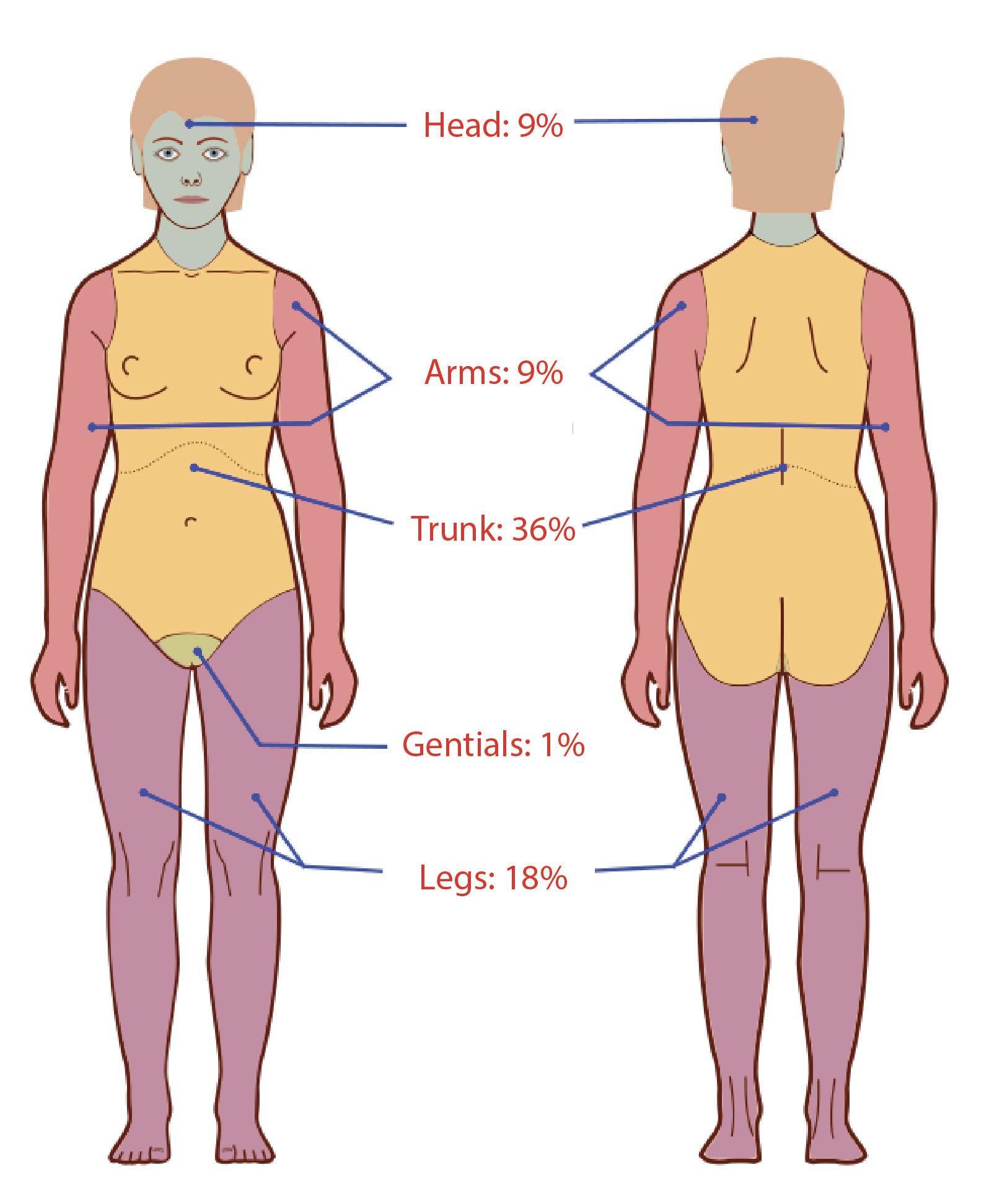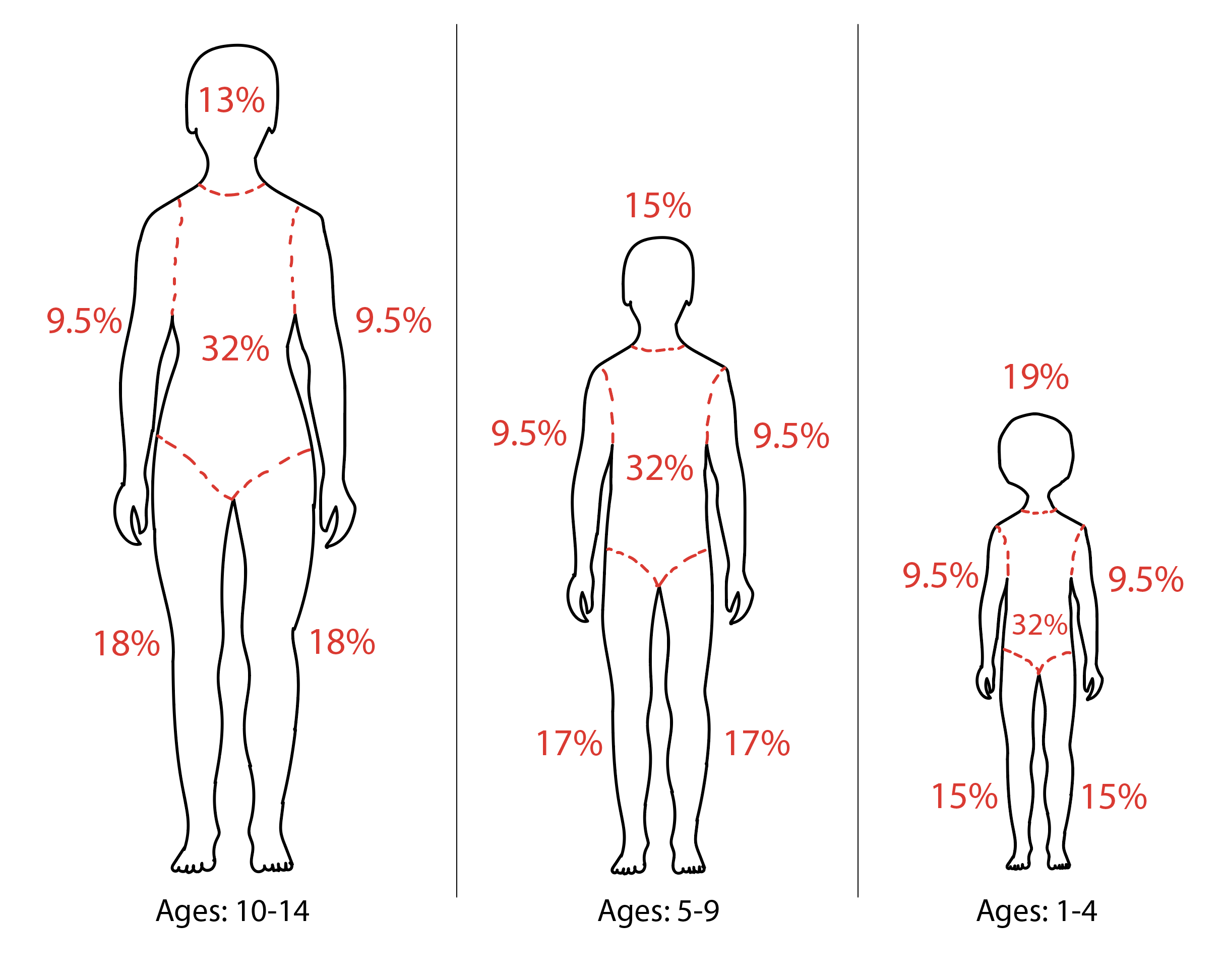[1]
Williams RY, Wohlgemuth SD. Does the "rule of nines" apply to morbidly obese burn victims? Journal of burn care & research : official publication of the American Burn Association. 2013 Jul-Aug:34(4):447-52. doi: 10.1097/BCR.0b013e31827217bd. Epub
[PubMed PMID: 23702858]
[2]
Giretzlehner M, Ganitzer I, Haller H. Technical and Medical Aspects of Burn Size Assessment and Documentation. Medicina (Kaunas, Lithuania). 2021 Mar 5:57(3):. doi: 10.3390/medicina57030242. Epub 2021 Mar 5
[PubMed PMID: 33807630]
[4]
Ali SA, Hamiz-Ul-Fawwad S, Al-Ibran E, Ahmed G, Saleem A, Mustafa D, Hussain M. Clinical and demographic features of burn injuries in karachi: a six-year experience at the burns centre, civil hospital, Karachi. Annals of burns and fire disasters. 2016 Mar 31:29(1):4-9
[PubMed PMID: 27857643]
[5]
Thom D. Appraising current methods for preclinical calculation of burn size - A pre-hospital perspective. Burns : journal of the International Society for Burn Injuries. 2017 Feb:43(1):127-136. doi: 10.1016/j.burns.2016.07.003. Epub 2016 Aug 27
[PubMed PMID: 27575669]
Level 3 (low-level) evidence
[6]
Williams JF, King BT, Aden JK, Serio-Melvin M, Chung KK, Fenrich CA, Salinas J, Renz EM, Wolf SE, Blackbourne LH, Cancio LC. Comparison of traditional burn wound mapping with a computerized program. Journal of burn care & research : official publication of the American Burn Association. 2013 Jan-Feb:34(1):e29-35. doi: 10.1097/BCR.0b013e3182676e07. Epub
[PubMed PMID: 23292593]
[7]
Cheah AKW, Kangkorn T, Tan EH, Loo ML, Chong SJ. The validation study on a three-dimensional burn estimation smart-phone application: accurate, free and fast? Burns & trauma. 2018:6():7. doi: 10.1186/s41038-018-0109-0. Epub 2018 Feb 27
[PubMed PMID: 29497619]
Level 1 (high-level) evidence
[8]
Tocco-Tussardi I, Presman B, Huss F. Want Correct Percentage of TBSA Burned? Let a Layman Do the Assessment. Journal of burn care & research : official publication of the American Burn Association. 2018 Feb 20:39(2):295-301. doi: 10.1097/BCR.0000000000000613. Epub
[PubMed PMID: 28877135]
[9]
Borhani-Khomani K, Partoft S, Holmgaard R. Assessment of burn size in obese adults; a literature review. Journal of plastic surgery and hand surgery. 2017 Dec:51(6):375-380. doi: 10.1080/2000656X.2017.1310732. Epub 2017 Apr 18
[PubMed PMID: 28417654]
[10]
Rosenthal J, Clark A, Campbell S, McMahon M, Arnoldo B, Wolf SE, Phelan H. Effects of obesity on burn resuscitation. Burns : journal of the International Society for Burn Injuries. 2018 Dec:44(8):1947-1953. doi: 10.1016/j.burns.2018.06.002. Epub 2018 Oct 31
[PubMed PMID: 30391062]
[11]
Alvarado R, Chung KK, Cancio LC, Wolf SE. Burn resuscitation. Burns : journal of the International Society for Burn Injuries. 2009 Feb:35(1):4-14. doi: 10.1016/j.burns.2008.03.008. Epub 2008 Jun 9
[PubMed PMID: 18539396]
[12]
Greenhalgh DG, Cartotto R, Taylor SL, Fine JR, Lewis GM, Smith DJ Jr, Marano MA, Gibson A, Wibbenmeyer LA, Holmes JH, Rizzo JA, Foster KN, Khandelwal A, Fischer S, Hemmila MR, Hill D, Aballay AM, Tredget EE, Goverman J, Phelan H, Jimenez CJ, Baldea A, Sood R. Burn Resuscitation Practices in North America: Results of the Acute Burn ResUscitation Multicenter Prospective Trial (ABRUPT). Annals of surgery. 2023 Mar 1:277(3):512-519. doi: 10.1097/SLA.0000000000005166. Epub 2021 Aug 19
[PubMed PMID: 34417368]
[13]
Romanowski KS, Palmieri TL. Pediatric burn resuscitation: past, present, and future. Burns & trauma. 2017:5():26. doi: 10.1186/s41038-017-0091-y. Epub 2017 Sep 4
[PubMed PMID: 28879205]
[14]
Parvizi D, Giretzlehner M, Dirnberger J, Owen R, Haller HL, Schintler MV, Wurzer P, Lumenta DB, Kamolz LP. The use of telemedicine in burn care: development of a mobile system for TBSA documentation and remote assessment. Annals of burns and fire disasters. 2014 Jun 30:27(2):94-100
[PubMed PMID: 26170783]
[15]
Vaughn L, Beckel N, Walters P. Severe burn injury, burn shock, and smoke inhalation injury in small animals. Part 2: diagnosis, therapy, complications, and prognosis. Journal of veterinary emergency and critical care (San Antonio, Tex. : 2001). 2012 Apr:22(2):187-200. doi: 10.1111/j.1476-4431.2012.00728.x. Epub
[PubMed PMID: 23016810]
Level 3 (low-level) evidence
[16]
Colson CD, Alberto EC, Milestone ZP, Batra N, Salvador T, Fooladi H, Cleary K, Izem R, Burd RS. EasyTBSA as a method for calculating total body surface area burned: a validation study. Emergency medicine journal : EMJ. 2023 Apr:40(4):279-284. doi: 10.1136/emermed-2022-212308. Epub 2023 Jan 13
[PubMed PMID: 36639224]
Level 1 (high-level) evidence
[17]
Pham C, Collier Z, Gillenwater J. Changing the Way We Think About Burn Size Estimation. Journal of burn care & research : official publication of the American Burn Association. 2019 Jan 1:40(1):1-11. doi: 10.1093/jbcr/iry050. Epub
[PubMed PMID: 30247559]
[18]
Kamolz LP, Lumenta DB, Parvizi D, Dirnberger J, Owen R, Höller J, Giretzlehner M. Smartphones and burn size estimation: "Rapid Burn Assessor". Annals of burns and fire disasters. 2014 Jun 30:27(2):101-4
[PubMed PMID: 26170784]
[19]
Liu NT, Fenrich CA, Serio-Melvin ML, Peterson WC, Cancio LC, Salinas J. The impact of patient weight on burn resuscitation. The journal of trauma and acute care surgery. 2017 Jul:83(1 Suppl 1):S112-S119. doi: 10.1097/TA.0000000000001486. Epub
[PubMed PMID: 28452888]
[20]
Livingston EH, Lee S. Percentage of burned body surface area determination in obese and nonobese patients. The Journal of surgical research. 2000 Jun 15:91(2):106-10
[PubMed PMID: 10839957]
[21]
Stevens JV, Prieto NS, Ridelman E, Klein JD, Shanti CM. Weight-based vs body surface area-based fluid resuscitation predictions in pediatric burn patients. Burns : journal of the International Society for Burn Injuries. 2023 Feb:49(1):120-128. doi: 10.1016/j.burns.2022.03.007. Epub 2022 Mar 19
[PubMed PMID: 35351355]
[22]
Pisano C, Fabia R, Shi J, Wheeler K, Giles S, Puett L, Stewart D, Ziegfeld S, Flint J, Miller J, Aguayo P, Alberto EC, Burd RS, Vitale L, Klein J, Thakkar RK. Variation in acute fluid resuscitation among pediatric burn centers. Burns : journal of the International Society for Burn Injuries. 2021 May:47(3):545-550. doi: 10.1016/j.burns.2020.04.013. Epub 2020 May 16
[PubMed PMID: 33707085]
[23]
Prieto MF, Acha B, Gómez-Cía T, Fondón I, Serrano C. A system for 3D representation of burns and calculation of burnt skin area. Burns : journal of the International Society for Burn Injuries. 2011 Nov:37(7):1233-40. doi: 10.1016/j.burns.2011.05.018. Epub 2011 Jun 23
[PubMed PMID: 21703768]
[24]
Neaman KC, Andres LA, McClure AM, Burton ME, Kemmeter PR, Ford RD. A new method for estimation of involved BSAs for obese and normal-weight patients with burn injury. Journal of burn care & research : official publication of the American Burn Association. 2011 May-Jun:32(3):421-8. doi: 10.1097/BCR.0b013e318217f8c6. Epub
[PubMed PMID: 21562463]
[25]
Tran DP, Arnold DH, Thompson CM, Richmond NJ, Gondek S, Kidd RS. Evaluating Discrepancies in Percent Total Body Surface Area Burn Assessments Between Prehospital Providers and Burn Center Physicians. Journal of burn care & research : official publication of the American Burn Association. 2022 Jan 5:43(1):225-231. doi: 10.1093/jbcr/irab131. Epub
[PubMed PMID: 34289051]
[26]
Armstrong JR, Willand L, Gonzalez B, Sandhu J, Mosier MJ. Quantitative Analysis of Estimated Burn Size Accuracy for Transfer Patients. Journal of burn care & research : official publication of the American Burn Association. 2017 Jan/Feb:38(1):e30-e35. doi: 10.1097/BCR.0000000000000460. Epub
[PubMed PMID: 28009696]


